Master Recipe from “New Healthy Bread in Five Minutes a Day” using Vital Wheat Gluten!
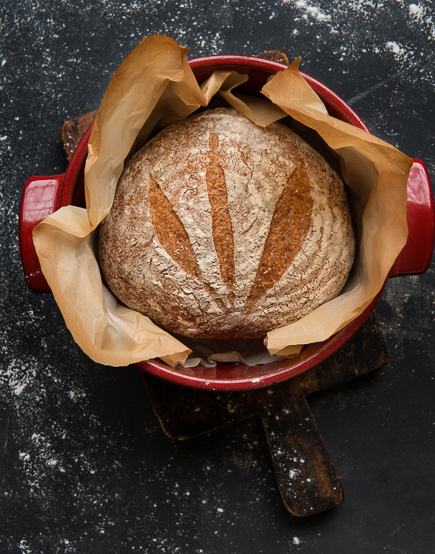
(The pictures in this post are by Stephen Scott Gross, who did the photography For New Healthy Bread in Five).
After writing the first edition of Artisan Bread in Five Minutes a Day in 2007 I was immediately asked how to convert the recipes to whole grains, and maybe even gluten-free equivalents. Through quite a lot of other adventures, the updated version has come out: The New Healthy Bread in Five Minutes a Day: Revised and Updated with New Recipes.
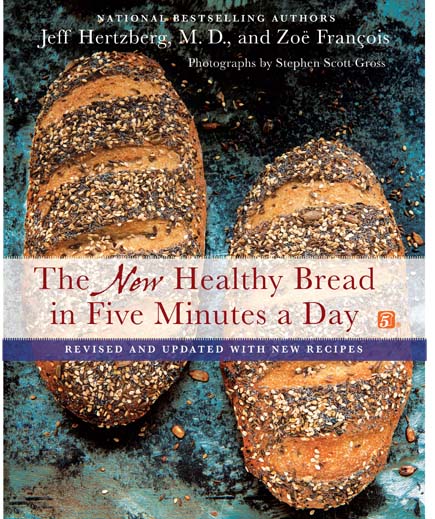
There are more photos to inspire you and make baking easier, all the recipes are in cup measures and weights, since we love baking with a scale and we’ve added charts for different kinds of flour, since there are so many on the market to choose from. And there’s a vast chapter of tips and techniques. Here’s a summary of what’s new in the new edition:
- Using sourdough starter as a leavening agent: for the first time in any of the books, instructions on creating your own starter and then using it as the leavening agent for homemade bread. Yeast bakers still have our original instructions as well.
- Weight equivalents for every dough recipe. Weighing’s more accurate and it’s catching on in the U.S. We’ve really made leaps and strides as a baking country since 2007 (when the first book was launched), because inexpensive digital scales have become available everywhere.
- Versions and options for omitting vital wheat gluten: Some of our readers asked how they could omit this from the recipes in the original Healthy Bread in Five Minutes a Day—which all called for added gluten. I’ve done that for the Master Recipe, and given some rules of thumb for doing it for the rest of the book as well (it’s a water adjustment).
- Using offbeat or ancient grains like spelt, Kamut (khorasan), and sprouted wheat: New rules of thumb for water adjustment when you use alternatives to standard supermarket whole grain flours.
- Other new ingredients that have started appearing in American pantries: Coconut and flaxseed oils work great in the recipes calling for oil.
- A gluten-free chapter: It has all the favorites from the book’s first edition, based on positive feedback from readers.
Now let’s dive into our Master Recipe, which didn’t change much, because it works so well and it is a great place to start for people who aren’t used to baking with whole grains. With whole grain baking you need more water, and one extra ingredient called Vital Wheat Gluten (sometimes labeled “vital wheat gluten flour”), which is available in most supermarkets, or mail-order/on-line from anywhere…
Whole grains can make for a drier results; all that bran soaks up water. So we increased the water for all the new recipes. But that was only part of it. I found that boosting the gluten content with vital wheat gluten increased the amount of time we can store the dough. Storing the dough is why these recipes are different from all others and makes baking so fast. Vital wheat gluten makes whole grain dough springy enough to be stored in the refrigerator as a large batch. There’s also a version without vital wheat gluten in the book for those who prefer not to use it or can’t find it.
What is vital wheat gluten? It’s the protein-rich part of wheat that creates the strands that trap gas bubbles and allow yeasted bread to rise (and stay risen). It doesn’t take much vital wheat gluten to make a difference in a 4 to 5 pound batch of whole grain dough. Just 2 to 4 tablespoons are all you need, so while the whole bag or box may seem expensive, it doesn’t add much to the cost of baking.
So where do you get vital wheat gluten? Most supermarkets in larger towns and cities carry it. The two brands in U.S. supermarkets are Bob’s Red Mill and Hodgson Mill, and we tested those extensively. If your local store doesn’t carry vital wheat gluten, you can mail-order it from Amazon; click for either the Bob’s Red Mill product, or the Hodgson Mill product (you can also order directly from those company’s websites).
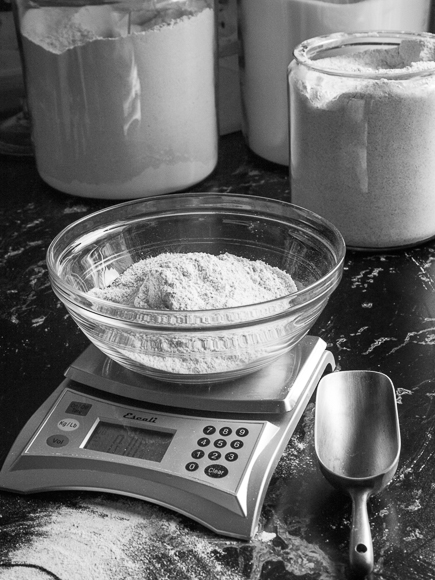
Master recipe from The New Healthy Bread in Five Minutes a Day:
There are many, many more details are in the book, along with plenty of recipes that are 100% whole grain; this recipe is about 73% whole grain:
Ingredients:
5 3/4 cups (750g) whole wheat flour – This is based on typical supermarket whole wheat, but we have a chart in the book so you can easily bake with King Arthur, Bob’s Red Mill, Sprouted Wheat, Kamut, Einkorn, Spelt or Hodgson Mill.
2 cups (300g) unbleached all-purpose flour
1 tablespoon (10g) granulated yeast – can decrease. You can use any kind of yeast including: instant, “quick,” rapid rise, bread machine, or active dry. You can also decrease the amount of yeast in the recipe by following the directions here. Or you can bake with a sour dough starter, see instructions here.)
1 tablespoon (15g) Kosher salt – can adjust to taste or health concerns
1/4 cup (40g) vital wheat gluten (or vital wheat gluten flour) – Here is a version without vital wheat gluten
4 cups (910g) lukewarm water (about 100°F)
1 to 2 tablespoons of whole seed mixture for sprinkling on top crust: sesame, flaxseed, caraway, raw sunflower, poppy, and or anise
To make the dough:

First, measure the dry ingredients into a 6-Quart Round Container or bowl, and whisk them together (you can also use a fork, or if it’s lidded, just shake them well). Mixing the dry ingredients first prevents the vital wheat gluten from forming clumps once liquids are added.
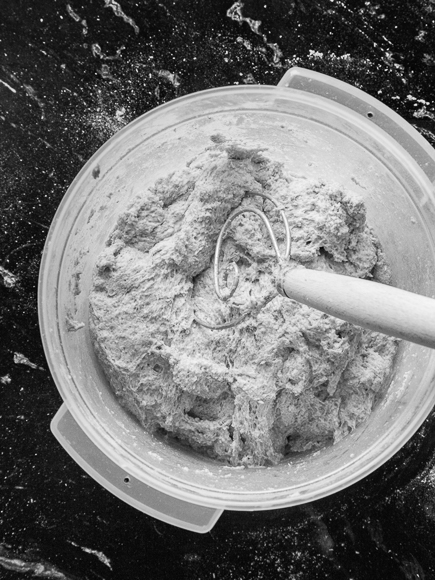
Add the water to form a wet dough and mix with a Danish Dough Whisk or wooden spoon.
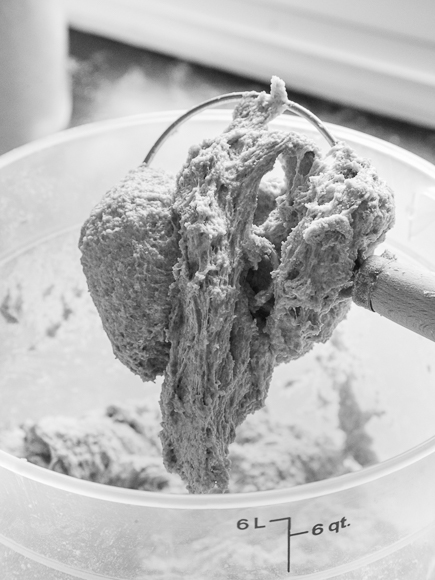
Don’t add additional flour to dry this out. It should be wet and shaggy.
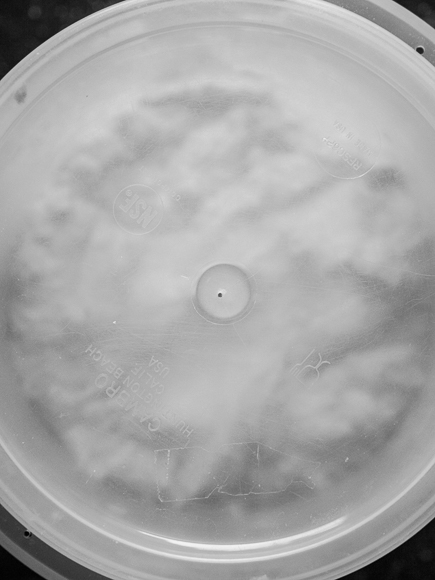
Cover loosely (leave lid open a crack) or you can piece a small hole in the lid, as you see above. Allow to rise for two hours at room temperature (if you decreased the yeast, you’ll need more time). NEVER PUNCH DOWN. The dough will rise and then begin to collapse. Refrigerate and use over the next 14 days, tearing off one-pound loaves as you need them.
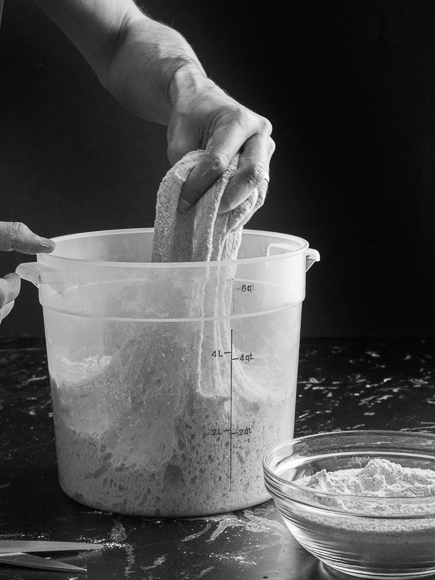
On baking day, cut off a grapefruit-sized piece of dough (about a pound), using a serrated knife or a Kitchen Shears.

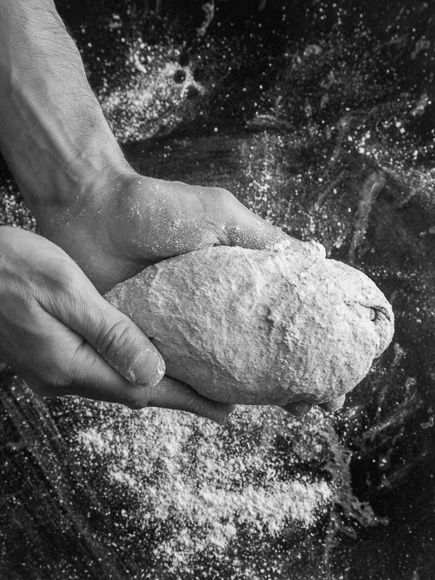
Quickly shape a loaf as you’ve seen in our videos on this website.
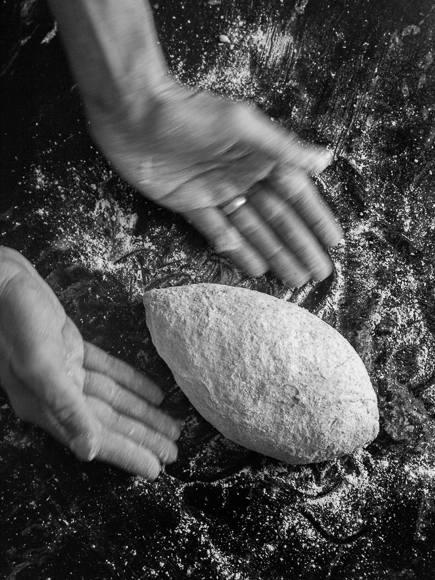
It should take less than a minute— you pull the top around to the bottom, rotating quarter-turns as you go. DON’T KNEAD or otherwise knock all the gas out of the loaf.

Cover the loaf loosely with plastic wrap and let it rest on a pizza peel covered with cornmeal or parchment for 90 minutes (40 minutes if you’re using fresh, unrefrigerated dough.) Depending on the age of the dough, you may not see much rise and it may spread out. The bottom loaf in the photo is just after shaping and then the one above it has rested and is ready for baking. Our loaves depend more on “oven spring” for rising.
Preheat the oven to 450°F (230 degrees C), with a baking stone placed on a middle rack. Place an empty broiler tray for holding water on any other rack that won’t interfere with rising bread.
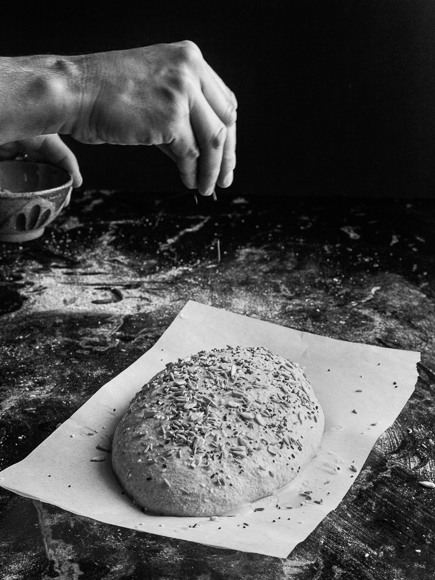
Just before baking, use a pastry brush to paint the top with water (we’ve dropped the cornstarch wash) and sprinkle with seed mixture.
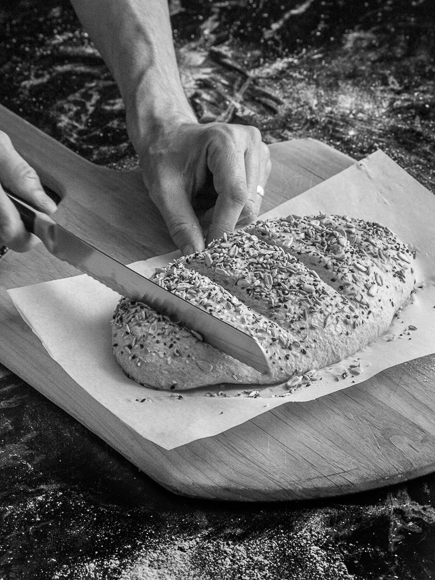
Slash the loaf with 1/2-inch deep parallel cuts across the top (or a singe lengthwise cut as in the first picture). Use a serrated bread knife held perpendicularly to the loaf:
Slide onto the hot stone…
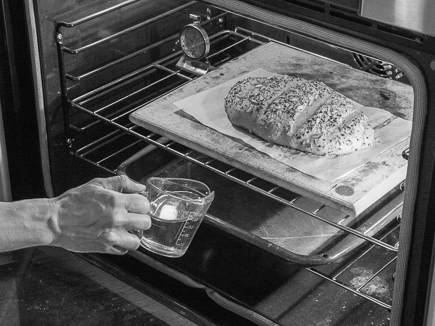
…and carefully pour 1 cup of hot tap water into the broiler tray (in the book, we give alternatives for creating that steam environment, which is essential for creating a great crust):
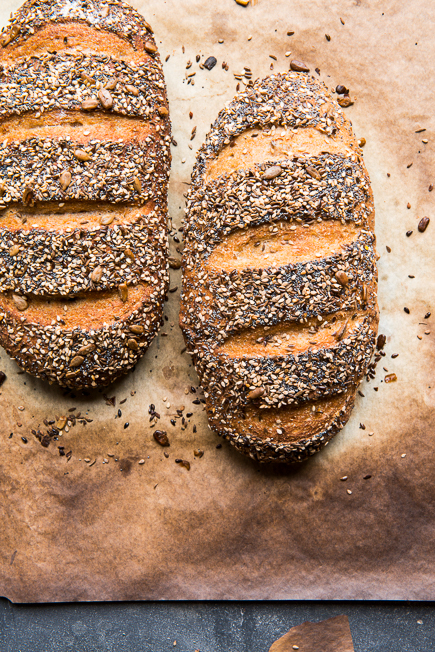
After a 30-minute bake, cool on a cooling rack.
Here are more shapes and ways to bake our Master recipe:

Slow Cooker bread from our Master recipe

Master recipe baked in a Cloche
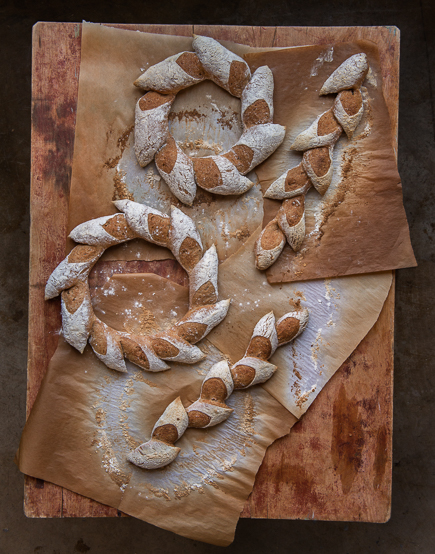
Epi and wreath from Master recipe
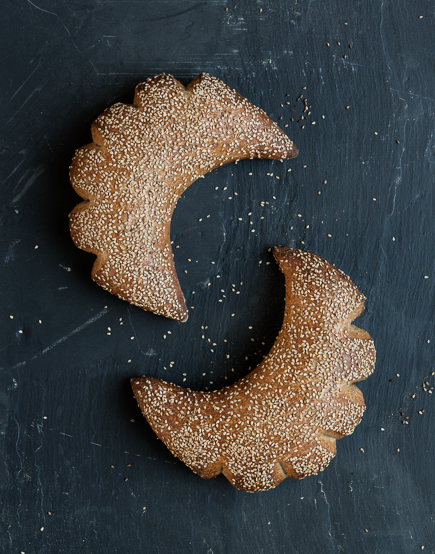
Moon and stars made from Master recipe. And there are many more in the book, plus 100 other recipes.
Note: BreadIn5.com is reader supported. When you buy through links on the site, BreadIn5 LLC earns commissions.
Instead of using a shears or knife to divide dough, can’t you just tear it off with your hands?
Hi Doug,
Cutting it just means you will be handling the dough less. We always suggest handling it as little as possible to maintain the air bubbles from the yeast. It should have quite a bit of stretch to it, which makes it a little more difficult to just tear out.
Thanks, Zoë
The Whole Grain Master Recipie was absolutely delicious. Can I bake this bread in a loaf pan for 2/3 of the tme and finish it on the stone for a loftier sandwich loaf?
Thank You,
Pat
Hi Pat,
I would leave the loaf in the pan until the last 10 minutes of baking, to make sure it is well set. Taking it out of the pan will just crisp up the crust, but will not change how lofty the loaf is. You will also need to use more dough to bake in a pan and let it rise and bake longer. Here is a post about baking in a loaf pan: https://artisanbreadinfive.com/2011/09/12/the-best-school-lunches-start-with-homemade-bread
Thanks, Zoë
Hello Zoe,
A little more dough in a loaf pan produced a more sandwich-like, cuttable loaf. Baking your whole grain bread in a 3 to 4 quart sized, covered, cast-iron or ceramic pot (a la Lahey), also contributed to a higher loaf. I’ve become obsessed with healthy bread baking and actually grind the whole wheat. The bread comes out very dark and crusty on the outside and tender inside. I use a little orange juice in the water for the recipe, to sweeten the taste of the wheat a bit, without adding sugar. Thank you for those prompt answers and suggestions.
Hi Pat,
Glad to hear you are baking and enjoying the whole grain breads!
Cheers, Zoë
Can we combine ingredients in a stand mixer to ensure well combined?
Shelley: Sure can.
Glad to see someone ditch the honey. I hate sweet bread. I was wondering if you absolutely need a baking stone. Does a cookie sheet do it too?
Larissa: You can do it– crust won’t be quite as good.
Is there a way of substituting or completely skipping the vital wheat gluten? If I do skip it, how will it affect the end result?
Baigal: There’s no substitute, but you can leave it out if you decrease the water a bit (1/4 cup?). But– the result will be denser, a little dryer, and the dough won’t store as well as in the fridge– it will become over-dense sooner than our stored whole-grain dough with VWG.
I love your artisan bread and have been making it for our family for years now. I have a question though about flours. If I have bread flour, can I use that in place of the white flour, or does it change the consistency significantly? Thanks!
Kristi: Check our FAQs tab above, and choose the “Types of Flour…” entry.
Hi! I tried the recipe today, but the bread came out hard on the outside, is there a way to make it just a tad softer? More water in the broiler pan perhaps? Thanks!
Judy: A more tender bread comes from a little oil and sweetener. 2T of each for starters?
Hi, I made the dough yesterday and today pulled some dough and it ripped right off. I didn’t have to cut it. Let it rest for 90 minutes but it didn’t rise. So I let it rise for more time and then read here that it may not rise. I used the recipe from the video. I am preheating oven now and will bake. I have the first book! Love this method. Thanks for this website.
Hi Pastora,
The whole grain doughs are less stretchy than the all white doughs, so it is not unusual for it to break off. Although, this can also be a sign that the dough is too dry. Let me know how it comes out.
Thanks, Zoë
I took it out just at 30 minutes and realized it was too soon, so back it went. It is crusty just the way I like it with a custard crumb! I won’t be buying bread anymore and can’t wait to get your second book. Thanks for your help.
Hi Pastora,
Thanks for letting me know, enjoy!!!
Cheers, Zoë
I made the dough and used some of it a few times. The last two uses from the bucket, in the refrigerator, about 1.5 weeks old, the dough was extremely wet and took lots of flour to shape. Is this normal? It also seemed to stick to my improvised peel as well as to the baking stone. Love the recipe and the books. Thanks
Hi David it is not unusual for the dough to loose some of its structure as it ages, but it will happen even more if the dough goes unused for several days. Here is a post about shaping very wet dough: https://artisanbreadinfive.com/2010/03/08/new-video-shaping-the-ball-from-a-very-wet-dough
Thanks, Zoë
I have made several of your breads from Artisan Bread in Five Minutes a Day and love all of that I have made! I have recently found out my kids have to be gluten free. Have you ever considered making a gluten free version of your bread?
Thanks
Hi Lisa,
All of our other books (Healthy Bread in Five and Pizza and Flatbreads in Five) have gluten-free chapters. Here is a good recipe for you to try out: https://artisanbreadinfive.com/2010/01/05/gluten-free-crusty-boule
Thanks, Zoë
Thanks! I am excited to try it. I will report back with my families opinions!
Lisa
You might try grinding your own heirloom wheat, like Red Fife, or other varieties that we what people were eating before 1900. Many who think they are gluten intolerant just have problems digesting modern hybrid grains.
I have two questions for you:
First, can the above recipe be done with no all-purpose flour, just the wheat flour and the vital wheat gluten?
Second, are the cuts in the top of the loaf solely decorative, or do they serve a necessary purpose?
Thanks!
-Luke
Hi Luke,
This loaf will be too dry if you use just whole wheat, without adjusting the water. There are many recipes in HBin5 that are 100% whole wheat if you prefer to bake without all-purpose flour.
Thanks, Zoë
This bread recipe is delicious- I am ordering your book pronto! I have one question though- my dough turned out pretty wet. I measure my flour- how much should 1 cup of flour weigh for your recipes?
Lindsay: white: 4.9 to 5.0 ounces, and whole wheat 4.5 ounces. See https://artisanbreadinfive.com/2010/04/28/how-we-measure-our-flour-using-the-scoop-and-sweep-method for how we measure when we use volumes.
Thanks so much! Off to make my third batch within three days 🙂
The last photo above leaves me thinking that the loaf doesn’t rise very much. Am I misintepreting? I’d like to try this for whole wheat baguettes, but am a little worried about the rise.
High whole grain breads certainly don’t rise as much as white-flour ones. Different effect.
I just made a loaf using the basic recipe that appeared in the Mother Earth News Dec2008/Jan2009 issue. I used nothing but 100% white whole wheat flour, also labeled as “ultra grain” flour. Except for an addition of about a tablespoon of honey for flavor, which I enjoy in whole wheat bread, and an increase of 1/2 cup water, I followed the directions to the letter. The result was a perfectly risen, moist, dense loaf of 100% whole grain slicing sandwich bread with a delightfully nutty flavor with just a hint of sweetness. The crust wasn’t the nice crisp one I get with white flour, but I’m just thrilled to have a moist loaf that rises well and is 100% whole grain! As a previous poster said, I’m never buying bread again. Thanks to both of you. I’m buying your book the first chance I get.
I wanted to clarify my post. I meant to say that I did not use any vital wheat gluten whatsoever in my white whole wheat loaf.
Thanks!
I’m excited to try this recipe! I have one question though – can I mix the wholeseed mixture into the dough instead of sprinkling on top?
Sure!
Do you mix the seeds in with the master mix or when you separate it out for baking?
You can incorporate seeds into the Master mix for the whole batch, our you can choose to roll seeds into each individual loaf, as in https://artisanbreadinfive.com/2010/06/10/announcing-winners-of-the-king-arthur-gluten-free-ingredients-and-new-video-on-how-to-roll-fruit-and-butter-into-lean-dough but just use seeds, no butter and fruit.
Hi,
I have just been introduced to your fantastic method by a friend and will be ordering the healthy breads book.
In the meantime, I made the dough in this post but only half the amount to see how it “behaves”.
I used store bought finely ground and sifted whole wheat flour + regular all purpose. The dough did not fall but it did straighten out and I stored it in the fridge after some 5 hours of resting in room temperature.
I have 4 questions:
When storing the dough in the fridge, do I cover it air tight or leave it slightly open?
Second questions regards the part where I cut off a piece for baking. With the white flour recipe, the instructions are to powder the surface of the dough with flour and then cut off a piece. How do I do it with the WW?
Do I also flour the surface of the dough? Do I wet or oil my hands?
Third, should I set the dough I cut off on cornmeal? I am asking because I am referring to WW.
Lastly, I will be baking the bread on a regular baking sheet on a baking pan + a baking pan with water. Is this the preferred way for WW or is a bread pan a better choice? I don’t have the stone.
Thank you in advance for your answer!
Lee
Lee– slightly open
Same cut-off method with WW
Cornmeal or parchment work well
Matter of taste for the pan vs freeform question; see our post on loaf breads at https://artisanbreadinfive.com/2011/09/12/the-best-school-lunches-start-with-homemade-bread
Hi, I have two questions
1. What is the best way to get the water to lukewarm? I usually leave it out on the stove. Is it okay to heat up the water on the stovetop or will that kill the yeast?
2. How should I store the bread? I usually take a week to eat it and have currently been putting it into a ziploc bag.
Hi Esther,
I just use the warm water from my tap. If you drink the water from the tap, there is no reason not to use it in the bread. If your water source is cold then you can warm it on the stove, but make sure it is just warm to the touch, like a baby bottle, if it is too hot, it will kill the yeast.
Here is a post on storing the bread: https://artisanbreadinfive.com/2010/01/04/storing-bread-whats-the-best-way
Thanks, Zoë
I never use warm water. I use the filtered water tap, which is usually room temperature. I always put the dough in the fridge, so I don’t see the point in using warm water. It still works fine.
Hi Kirsten,
Using room temperature or even cold water will certainly work and some people even prefer it, but it just takes much longer to rise. If you have the time to spare, then by all means it is a great way to go.
Thanks, Zoë
I am SO STOKED. I have been making your original basic recipe for a few years, sharing it with everyone and getting them addicted too. I usually use all whole wheat flour with the regular recipe….but now am ready with wheat gluten today!!! THANK YOU for your foodie brilliance. You make my life better and my hips fuller! (And yes, I have blogged about your bread.)
I have been making whole wheat bread in the bread machine for months, and just recently perfected my recipe with 100% whole grain (after MUCH experimentation and seeking out the perfect flour – I don’t have my own flour mill). However, using a bread machine takes almost 4 hours on whole wheat cycle, and it only makes one large loaf (or the equivalent of two smaller ones). So I stumbled on your website and I just tried mixing up my first whole wheat recipe last night. Thing is, I didn’t realize that I made a HUGE mistake until this morning. I had to halve the recipe since I didn’t have a five-quart container, but I mistakenly didn’t halve the water (I haven’t made a mistake like that in the kitchen in a long time!). Thus, the dough is VERY sticky. Is there a way to salvage it? I added some more flour to a pound and I’m trying to cook a loaf in the crock pot right now, but I need to know if it’s even worth salvaging, or if I need to try mixing up a new batch.
Any help would be great, and I’m so glad I found you guys on here! I’m always seeking out that “perfect” bread recipe, since our family uses a lot of whole-wheat bread for sandwiches, and my daughter might as well be addicted to bread, she eats it so much!
Hi Dinae,
Yes, you can absolutely fix the dough, just as you thought, you’ll want to add more flour and probably a touch more yeast and salt. If you don’t have a container to do it all at once, you can break the dough into two batches. Once you add the new ingredients, let the dough sit to allow the excess water to be absorbed.
Thanks, Zoë
Thanks so much for your help! The bread was much better when the water ratio was no longer so much more than it needed to be!
Thanks again!
Dinae
Can I use a bannetons with other recipes besides the
Bavarian one?
absolutely– anytime you want a round loaf.
I’ve just begun baking bread (at age 59!) and can’t thank you both enough for de-mystifying the process and giving me a few master recipes. So much easier than 1 recipe per bread type.
If I want to mix the whole grains into my loaf, am I correct in thinking that the given measure of 1-2 tbls is PER loaf? Am I also correct in thinking that I can add the grains when I mix the master dough? Next recipe to try – pizza! 🙂
Duffy, I’m confused. Where did you get 1-2 T per loaf, the recipe on this page has a lot more than that. Which of our books/which page number are you working out of?
Hi Jeff,
I got it from the ingredient list on this web page:
“1 to 2 tablespoons of whole seed mixture for sprinkling on top crust: sesame, flaxseed, caraway, raw sunflower, poppy, and or anise”
Yes, it’s really “to taste,” whatever thickness of coating of seeds you like. And alternatively, yes, right in with the dough mix.
Okay, I’m hoping you can help me! I made two loaves of boule from the Whole-Grain Master Recipe. Neither has “sprung up” as much in the oven as I had thought. The second one, on Zoe’s advice, I let rest for an extra half-hour, for a total of two hours of resting time before putting it in the oven, but still, the bread came out fairly flat. What could I still be doing wrong? Thank you!
Hi Sara,
if I remember correctly, your dough was a bit dry. What kind of flour are you using?
Thanks, Zoë
Hi Zoe! I’m using Hodgson Mill Whole Wheat Flour, and white flour (just the plain, store-brand stuff). The dough didn’t feel dry, though–if anything, it felt overly wet. I appreciate your help! How great that even with how busy you both must be, you find time to answer individual questions!
I just had a thought–it’s very possible that the water I used was too warm. Now that I think back, it was almost certainly a good deal warmer than 100, maybe even bordering on hot rather than lukewarm. Would that keep the bread from “springing up” in the oven?
Hi Sara,
Yes, very warm water, bordering on hot, may kill off some of the yeast. But, if you had any rise at all, it means that some of the yeast survived and it should behave well. If your dough was overly wet, it can sometimes be a matter of knowing how to shape the loaf. Here is a video that may help: https://artisanbreadinfive.com/2010/03/08/new-video-shaping-the-ball-from-a-very-wet-dough
Thanks, Zoë
Thank you! I want to share with you that my 20-month-old daughter has been going through a phase of refusing (store-bought) bread. No matter how I gave it to her–toasted, untoasted, plain or with peanut butter or jam–she was just refusing it. Then I made a loaf of the sandwich bread from your first book, subbing about half the flour with white whole-wheat flour. I gave her a slice for breakfast this morning, with a little jam on top, and she devoured it!
Hi Sara,
What a great story, your daughter has fabulous taste! 😉
Cheers, Zoë
Okay, sorry–one more (last) update because I don’t want to monopolize the comment stream! But I did want to let you know that I think I figured out the problem. I had been using bleached flour but not adjusting the AMOUNT of flour up or the amount of water down. Also, I’d been using basic whole-wheat flour. I just mixed up a batch using white whole-wheat flour instead of basic WW flour, and upping the amount by 1/4 cup to compensate for the use of bleached flour, and the first loaf is in the oven, springing up like crazy, as I type this!
Thanks so much for your help!
Hi Sara,
That is great news, so glad it is working better for you!
Cheers, Zoë
Just tried your basic recipe. I mixed it up yesterday. I am using my own fresh ground ww flour. I am glad I happened to see your video that said a cup of flour is 5 oz. I weighed mine, and it was only 4 oz, so I went by weight in mixing up my bread. It did seem a bit dryer than yours, but rose beautifully, just like your demo. Today, 4th of July I pulled it out and made a loaf. It broke off without me having to cut it, didn’t seem to rise very much, but I went ahead and cooked it and it was fantastic. Just the right texture and amazingly yummy! Thanks so much, I look forward to the next few loaves. This is definitely the simplest process I’ve ever done and I’ve been making yeast bread for 50 yrs.
Great, so glad. Also see our post on fresh-ground flour at https://artisanbreadinfive.com/?p=1165
I just tried your whole grain master recipe tonight, which was my very first attempt at making homemade bread! The flavor was great but the dough didn’t really rise at all and was extremely dense. Did I do something wrong or is there something I could do to make my second batch more light and fluffy? Any help would be greatly appreciated!
Assume you used vital wheat gluten but I’m guessing you used a coarse-ground whole grain flour; if so, try a typical commercial product like Gold Medal Whole wheat. Have you been through the tips and techniques in the book (chapter 4)? Much more in there. And be sure to do the full rest– 90 min. Check our FAQ above, on “Dense crumb…”
Just read this & realize that I completely MESSED up the original Artisan Bread in 5 mins recipe. Now that I know what I did wrong, is there anyway to ‘Save’ the ‘mixture’ that I have already created?
I used 6 1/2 cups of Whole Wheat Flour, zero Vital Wheat Gluten, but followed everything else on the Artisan Bread in 5 mins recipe.
HELP!!!
Hi Danielle,
The problem is that whole wheat flour absorbs a lot more water and creates less gluten, so the dough will be much too dry and won’t have enough structure to rise well. Your best bet is to add more water to the dough. You’ll want to start with about a 1/4 cup and see where that gets you. You should watch some of our videos to see what the consistency of the dough is meant to look like when mixing and after it has risen.
You breads may spread a bit, so for this dough I may suggest you use a loaf pan.
Thanks, Zoë
Thanks Zoe, will try adding water…is that ALL I need to add? Again, I followed the reg. Artisan Bread in 5 min receipe, the only change I made was using wheat floud instead of white flour.
Thanks!
Danielle
Hi Danielle,
Yes, as you know, we generally recommend adding vital wheat gluten to breads made with a high percentage of whole wheat, but it can’t be added after the dough is already made. You have to whisk the VWG in with the whole wheat flour or it doesn’t mix properly. Try just adding water to this batch and next time you can add VWG at the start.
Thanks, Zoë
Just found out about the WW method. Can’t wait to try this. The 5 minute artisan bread was published in the Charleston, WV, Sunday Gazette in, I think, January 2006 and I’ve been using it for all that time. So good, we don’t get a lot of wait time with it. We have been making it into a pepperoni cheese loaf, rolling it out like cinnamon rolls, topping it and rolling it back up from the short side. Of course the cinnamon rolls are heavenly. A question: my younger daughter loves pumpernickel bread. Is there any way to “pumpernickel-ize the WW recipe.
Hi Ruth,
Yes, we have several Pumpernickel recipes in our books. It sounds like you want one with whole grains, so I would check out the recipe in Healthy Bread in FIve Minutes a Day.
I think your garlic knots will work beautifully. We have a recipe for garlic knots in Healthy Bread as well, but these crescent rolls may do the trick: https://artisanbreadinfive.com/2011/09/21/rosemary-crescent-rolls
Cheers, Zoë
Have been thinking about garlic knots to dip in marinara. What about rolling the dough out like a cinnamon roll, topping it with olive oil, garlic, and parmesan and rolling it back up from the long side, and cutting rounds out.
How critical is the water? Our sailboat has a gas oven with only a single oven rack so no where to place a pan of water.
Not a huge deal– the crust won’t be as brown and it won’t really crisp. But these are less of an issue with whole grain breads.
Hello!
I just made this recipe and it turned out great =) The bread is soft with lots os bubbles after baking, with a crispy crust.
My only problem was the fact I wasn’t able to “slash” the top because the dough was to soft.. does that mean I need to make it drier the next time? I looked similar to the video.
Thank you! (Marisa- Portugal)
Dust surface with flour, then stabilize the loaf with your other hand. A serrated knife, especially a bread knife, will go through dough even when it’s this wet.
Just trying this recipe for the first time. Followed precisely and found that the dough was very dry, not wet. Fearing changing your recipe, I just left in bowl to rise (doing that now). Will my bread be ok? or should I have added more than 4 cups of water? I used the Vital Gluten as directed too.
Thanks!
Matt
See our video on this, which shows how wet it should look: https://www.youtube.com/watch?v=hDBJkxoNpE8 Other videos on YouTube.com/BreadIn5. If yours looks drier, yes, prob should’ve added more water. Did you use a home-ground or other coarse WW? May want to re-create it with a standard supermarket WW, like Gold Medal or other.
Can work in a little water after the fact.
Thanks for the Sunday reply Jeff! I used a standard flour (King Arthur WW). Too late to add more water now since it has been in the fridge for a few hours. We’ll just have to see how it turns out. Kinda surprised that I followed the recipe to the T and got such dry dough….
You actually can work a little water in, it’ll recover. But make a loaf first…
And what if you dont have a stone to cook it on?
Hi Rachel,
You can bake on a cookie sheet or in a Dutch Oven: https://artisanbreadinfive.com/2009/03/11/baking-bread-in-a-dutch-oven
Thanks, Zoë
How much water should be added to a dough when adding 1/4 cup vital wheat gluten to a recipe?
Also, with the varying absorption rates of different grain flours, are you aiming for any specific hydration levels in the doughs of Healthy BreadsIn5?
For what it’s worth, I’ve weighed Bob’s vital wheat gluten about 10 times and keep coming up with 35 grams per 1/4 cup (stirred, scooped, & leveled). His packaging says 30 g per 1/4 cup. I do have a pretty accurate scale (Edlund E-160).
This is going to be a Veddy Bready Christmas! Thanks to you both for all the time you spend for us Breadheads.
Hi Rita,
The hydration is really going to change a lot depending on the flours you are using. If you are using the HBin5 book, we already have amounts of water for each recipe, so you shouldn’t have to alter that, unless you’re changing the recipes.
You are getting the same weight for vital wheat gluten that we get, based on our chart on page 36 in HBin5. They may be spooning the vital wheat gluten into the cup at Bob’s, but that’s not how we tested the recipes.
Thanks and happy baking! Zoë
Thank you, Zoe. I must have been thinking of the Bob’s vital gluten bag and got my sources backwards. I think there are more scoopers than spooners out there too.
Actually, I was asking about the vital gluten/water ratio because I was thinking of playing with the gluten in some older recipes of mine. Can’t help experimenting.
Hi Rita,
You will need more water for whole grain recipes and less for AP. 1/4 is a lot of vital wheat gluten, unless you are going for a multi loaf batch. I think a tablespoon or two is more typical in a single batch and you may want to start with an equal amount of extra water and go from there, depending on flour.
Good luck, Zoë
Thanks so much, Zoë! I typically at least double a batch, sometimes more, so your suggestion will be very helpful to give me a starting point. I’ll take your advice and creep up on it too.
With baking season upon us, I hope we don’t wear you and Jeff out!
You are so welcome Rita!
Have fun and let me know what you come up with!
Cheers, Zoë
I having been baking bread for 20 something years, and came across your online recipe. That’s generous of you to share. Anyway, I gave it a try, and have to say it is outstanding. I hated kneading, despite getting a good workout, so your approach is especially welcome!
I have the book on my Xmas wish list, so hopefully Santa will bring it soon. If not, I will buy it myself!
A couple of minor variations, which worked well for me. One is to proof the yeast using a 1/2 cup of water and reaspoon of brown sugar. The dough rises beautifully. Second is to use bread flour instead of the plain flour. It gives that bit of extra texture I think. Also, my first loaf stuck to the parchment paper I used, so now I use a non-stick silicone baking sheet. Works like a charm.
Thanks again, and I can’t wait to try more recipes!
Hi Roger,
Thanks for trying the recipe, all your variations sound like good ones, hope you get the book for Christmas!
Cheers, Zoë
I forgot to mention that I adjust the amount of water to account for that used in proofing the yeast.
Made your No Knead Artisan Bread yesterday. Needless to say, it is all gone today. I gave away a couple of loaves and when the family came over they ate the rest. Today I am going to try the Whole Wheat version. Can I use 7 grain flour in place of whole wheat?
Hi Carolyn,
I think it should work just the same, but I’ve never tried it, so you may want to make a half batch just to make sure you like the results!
Cheers and enjoy the bread! Zoë
Thanks. I’ll try that.
Just got your new book last night. LOVE it. Can’t thank you both enough. Going to try out the whole grain master recipe now. One question. I recently purchased a seven grain bread flour (from great river organic milling) in hopes of trying out more whole grain breads. I would like to substitute the whole grain flour for wheat flour in the whole grain master recipe. So my question is: should i increase the water quantity and/or vital wheat gluten amount to get a loaf that isn’t very dense? Thanks again.
Hi Deepa,
I have a feeling it is going to behave just like whole wheat, so I think you can use it in place of whole wheat in our recipes. You may want to try a half batch just in case. If the dough seems to wet or dry you can always make adjustments with no harm to the dough.
Thanks, Zoë
Thanks, Zoe, for your reply. I tried the recipe with the 7-grain substitution and it came out okay. Well, one out of the four loaves I made was really good (which was surprising, since I can’t think of anything I did differently with the baking. I was wondering if you could tell me if there are any tricks to making the dough rise better – i.e. more yeast or whether a wetter dough would make the difference? I will keep experimenting. Overall, I love how simple you and Jeff have made the whole bread baking experience so that beginner bakers like me can explore this.
Thanks again.
Those suggestions are all on the FAQs page, the one that reads “Dense crumb…” Those are the tricks. Longer resting time is one I always come back to. The fact that a single recipe is coming out differently all the time suggests it’s the measuring technique, so check the FAQs “Measuring…” and also “Weighing…”
Hi Zoë and Jeff!
I’ll be working with the recipe for 100% Whole Wheat Bread with Flax (HB5, page 86). I have the following pans and would like to make different-sized loaves depending on the recipients. It’s so much fun to give breads to friends. Could you please give me some guidance as to the dough weight appropriate for each pan? I’m excited about this bread because I used to love the flavor of flax in a favorite breakfast cereal as a child. Thank you.
(All Top Measurements)
Standard: 8 1/2 x 4 1/2”
Standard: 9 x 5”
Hearth Rye pan (has a rounded bottom and cuts into oval slices): 12 x 7 x 2.5″h
Long loaf: 12 1/2 x 5” x 3”h
Would it be helpful for me to measure the capacity of each for you?
My best guess, from the top of your list to the bottom (pounds):
1.5
1.75 to 2.00
2.25 to 2.50
2.25-2.50
Estimates–but the way I’d really do it is by seeing how high the dough comes. Before oven spring, it should be about 3/4 full if you want it puffing roundly and exuberantly over the rim, and 1/2-full if you don’t.
Thank you, Jeff. Those weights will give me a very good starting point. Also your extra tip about the height of the loaves. Love the exuberantly! 🙂
Great! Couldn’t think of a better word 😉
I have downloaded your most recent version of ABin5 and your Healthy ABin5. I plan to only use 100% White WW flour from Trader Joes. Do I need to use the vital wheat gluten? Many of your recipes in the Healthy book use some amount of white flour which I don’t want to use. Can I substitute 100% White WW?
Hi Deb,
You will still need the vital wheat gluten. The VWG allows the bread to be stored and still get a nice rise over time. If you substitute the white whole wheat you will need to add more water to the dough, since the whole wheat absorbs more water. I would start with 1/4 cup and see if that creates a nice elastic dough. You may want to make it once as written, just so you know what the consistency should be. You can also follow the ratio of water and flour in the 100% whole wheat loaf.
Enjoy, Zoë
Hi Zoe,
So I baked my first 100% whole wheat loaf. I used the VWG exactly as outlined in the recipe. The bread was good but I would like a bigger crumb. I know I could do it if I used one of your recipes with a mixture of wheat and white flours but can I get a larger crumb if I add more VWG? If so how much do I increase it by? What if I increase the water?
Hi Deb,
You can try increasing the VWG by a couple of tablespoons and the water by about the same or up to 1/4 cup. You want to becareful not to add too much VWG or the bread will get a rubbery texture.
Cheers, Zoë
I have been using your healthy bread in 5 min. a day master recipe with slight modifications. I have reduced the whole wheat flour to 590 grams and added 120 grams of rye flour and increased the vital wheat gluten to 40 grams.
I really like the bread as does the whole family. My only concern is that I haven’t been getting much of a rise in my cloche.today my wife suggested making a ring like a spring form pan out of parchment. The object was to contain the broule and encourage rising rather than spreading. She took to two four inch wide strips of parchment, layered them and stapeled them together to form a ring just slightly bigger in circumference than the 1 and 1/3 pound broule. We let in proof for 90 minutes on the stove top. It was on parchment on a pizza peel. Meanwhile the cloche was preheated to 450 degrees. I placed the broule with the parchment base and ring into the cloche and baked for 30 minutes covered and removed the cover for an additional 5 minutes. It is the tallest loaf to date. The parchment ring worked perfectly and will now be the standard method in our kitchen.
Hi LeRoy,
This is a great solution. I have done this with our panettone recipe, but had never tried it with the master recipe.
Cheers, Zoë
About shaping the loaf into an oblong rather than round shape:
Do you recommend the letter folding method or stretching & rolling method for this whole wheat recipe?
Thanks, Sharon
Hi Sharon,
I find the letter fold gives a nicer crumb, but it’s an extra step. Either way works well!
Thanks, Zoë
Hi I don’t have a grinder yet to make the flour but I as wondering how the glycemic index of fresh ground whole grain bread is compared to others.. can you comment on that?
Thank you
Maureen
Hi Maureen,
I asked Jeff, who is a Dr, and this is what he said. “We can’t find any evidence for an important difference. That doesn’t mean that a difference doesn’t exist or that someday evidence like that will emerge.”
Thanks, Zoë
I am sooooooo excited to have found out about your books. Hopefully the Easter bunny will leave them for me next month. Until then I have been busy making LOTS of things with the basic master recipe. I yesterday made the whole grains recipe from this post, but ran into a problem…after refrigerating the dough overnight I went to make a couple loaves. The dough is not stretchy at all. It did rise a lot during the 2 hours before refridgerating. I was able to form it into a loaf but is this ok? Could older gluten have caused this(I had some from previous recipes a about 8months ago)? Thanks for your help 🙂
Probably not the 8-mos old gluten, I think that should be OK. Are you using typical supermarket flours? If that’s not it, just increase the hydration a bit, maybe a quarter-cup?
Just made and tasted this bread and it’s the best yet. I have been baking ABin5 for about 4 months and just got the HBin5 book. Instead of 5c of whole wheat I use half KA white whole wheat and half Kamut flour. The Kamut flour adds a really great taste, beautiful texture and what a nice lighter brown crust. Thanks for your great approach to baking, I always have one or two “buckets” of dough in the frig and bake a loaf every day. Can’t remember when we bought bread at the store last.
Hi Tony,
Thank you so much for the note, we’re so happy you’re enjoying the bread!
Cheers, Zoë
Wow… I love this recipe. I have made the White Bread one and the Whole Grain is now in the oven… and it smells amazing… I never thought making my own bread could be this easy!! Thank you so much!
Fantastic Ashley!
I have made the Master Recipe for the Multigrain and it has turned out fine. 2 questions: 1. Can the dough sit on the counter longer than 2 hours for the initial rise in the bucket and 2. Can I substitute whole wheat bread flour for the whole wheat flour without changing the composition of the bread? Thanks!
The bread flour should be fine, but you may need to increase the water a bit (not sure, depends on how much more protein your brand of WW Bread has compared with ordinary). You might need to increase the water by 1 or 2 tablespoons.
About the counter-rest, see our FAQs tab above and choose “Left the dough on the counter overnight! Can I still use it?”
How would the rising time (90min) change for refrigerated dough if I make just a half-pound loaf?
Same question for the baking time (30min)?
Hi Bridget,
You can rest the loaf for about 60 minutes and bake it for 20 to 25 minutes.
Thanks, Zoë
Not sure where to post this but here’s my question – I bought a box of flax meal and I have a large jar of wheat germ. I use so little of each that I want to know if I can also just use a little in basic recipes – like put in a couple of tablespoons in place of the flour. It would add a healthy touch and would help me use up what otherwise I couldn’t.
thanks!
Hi Deborah,
No need to replace the flour, just add a couple of tablespoons of the flax and germ, it shouldn’t effect the dough at all.
Enjoy, Zoë
Hi,
I’m having a couple of issues/questions with my first few tries of this recipe. There are only two of us, so I’m cutting the amount in half, and using a plastic 5-quart bucket for storage. KA White Whole Wheat and KA All-Purpose for flours. Mixing, the initial rise, and the fall back during cold storage all seem to work per the article.
When I pull my bucket out a few days later to bake, the top of the dough has taken on an unattractive, gray color. I don’t think its mold, possibly just some drying or oxidation? At any rate, after forming, resting and baking, the finished loaf sometimes has streaks of the discoloration.
Have you seen this, and if so any ideas on how I prevent it?
Possibly related … If I decide to bake a loaf and pitas on the same day, when I lift up my dough (discolored top surface and all) the first half tears off before I can get enough clearance to use scissors; while the bottom half seems very wet. Should the dough be consistently wet top-to-bottom in storage, or does the water want to settle towards the bottom?
Thanks,
Alan
Have you checked out our FAQs tab (click above)? Water does settle to the bottom though.
Jeff,
Thanks for the reply, I had skimmed through the FAQ titles, but missed the “gray color” topic.
I’ll try dividing and transfer to smaller plastic tubs with tighter lids after one day in the refrigerator, to reduce my air space.
Cheers,
Alan